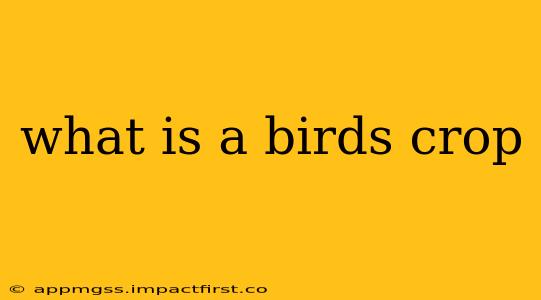Birds, with their diverse adaptations for flight and survival, possess unique anatomical features. One such fascinating structure is the crop, a vital organ often misunderstood. This comprehensive guide delves into the intricacies of a bird's crop, exploring its function, location, and variations across different species.
What is the Crop in Birds and What Does it Do?
The crop is a pouch-like expansion of the esophagus, located just before the stomach. It serves as a temporary food storage area, allowing birds to consume a large amount of food quickly and then digest it later at their leisure. This is particularly useful for birds that forage intermittently or encounter unpredictable food sources. Imagine a bird finding a bountiful supply of seeds – the crop allows it to gorge itself and then retreat to a safe location to process its meal without the risk of predation.
Think of it as a bird's natural "lunchbox."
Where is a Bird's Crop Located?
The crop is externally visible in some species, appearing as a slight bulge at the base of the neck. Its precise location varies slightly depending on the bird species, but it generally sits between the lower neck and the breastbone. You'll often find it easily palpable in birds with a less developed breast musculature.
Do All Birds Have a Crop?
No, not all birds possess a crop. Its presence or absence is largely linked to a bird's feeding habits and lifestyle. Birds that require quick, efficient food storage, such as pigeons, doves, and some seed-eating species, typically have well-developed crops. However, birds of prey or those with a constant food supply might lack this structure entirely. Hummingbirds, for instance, have a much higher metabolic rate and constantly need fuel, rendering a crop less necessary.
What is the Purpose of a Bird's Crop? (Expanding on function)
The crop serves several critical purposes beyond simply food storage:
- Temporary Storage: As mentioned earlier, the primary function is temporary food storage, allowing birds to consume large quantities swiftly and digest later in a safer environment.
- Softening Food: The crop's moist environment helps soften and partially digest food, especially dry or hard materials like seeds. This pre-digestion process simplifies the stomach's workload.
- Nutrient Absorption: Some limited nutrient absorption can occur in the crop, although the majority of digestion and nutrient uptake happens in the stomach and intestines.
- Parental Feeding: In some species, the crop plays a vital role in parental care. Crop milk, a nutrient-rich secretion produced by the lining of the crop, is regurgitated and fed to nestlings by pigeons and doves. This is a crucial source of nourishment for their young.
How is the Crop Different in Different Birds?
The size and structure of the crop vary considerably depending on the species and its dietary habits. Seed-eating birds generally have larger crops than insectivores. The crop's lining also differs; some have a relatively thin lining, while others have a thicker, more glandular lining capable of producing crop milk.
Does a Bird's Crop Affect its Health?
Problems with a bird's crop, such as impaction (blockage) or infection (crop mycosis), can significantly impact its health. These issues often require veterinary intervention. Observing your bird for any signs of crop issues – such as swelling, difficulty swallowing, or regurgitation – is crucial for timely diagnosis and treatment.
Conclusion
The bird's crop is a fascinating example of evolutionary adaptation, allowing certain avian species to thrive in various environments and dietary situations. Understanding its function and variations across species provides a deeper appreciation for the complexity and ingenuity of the avian world. Remember, responsible bird ownership includes awareness of potential crop-related problems and seeking professional help when necessary.
